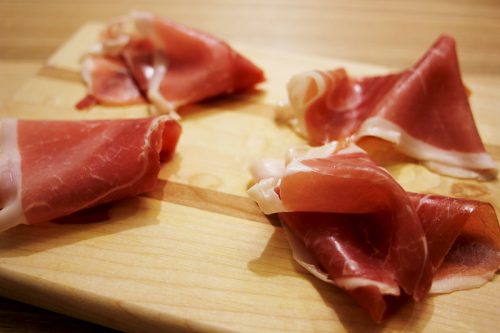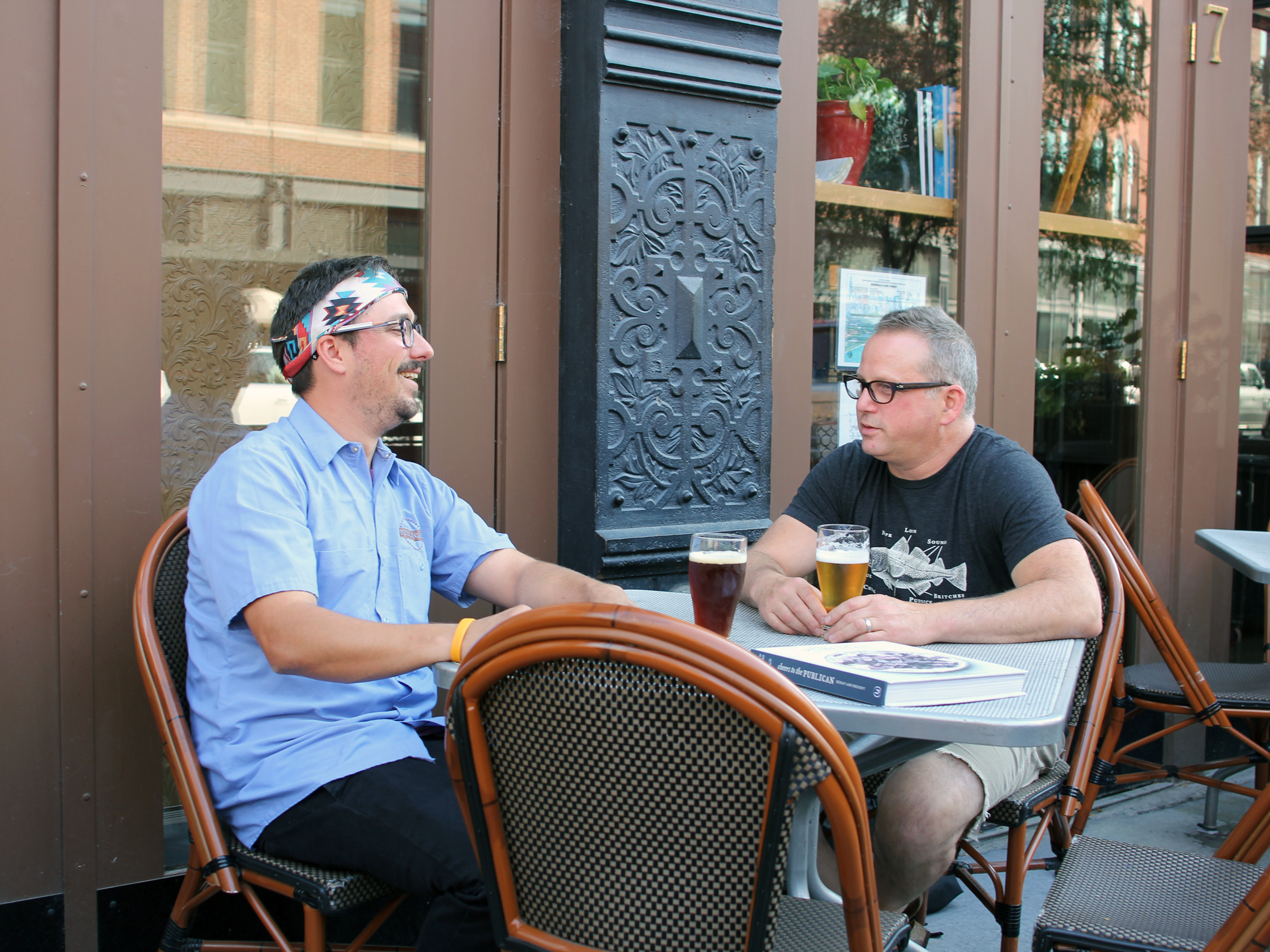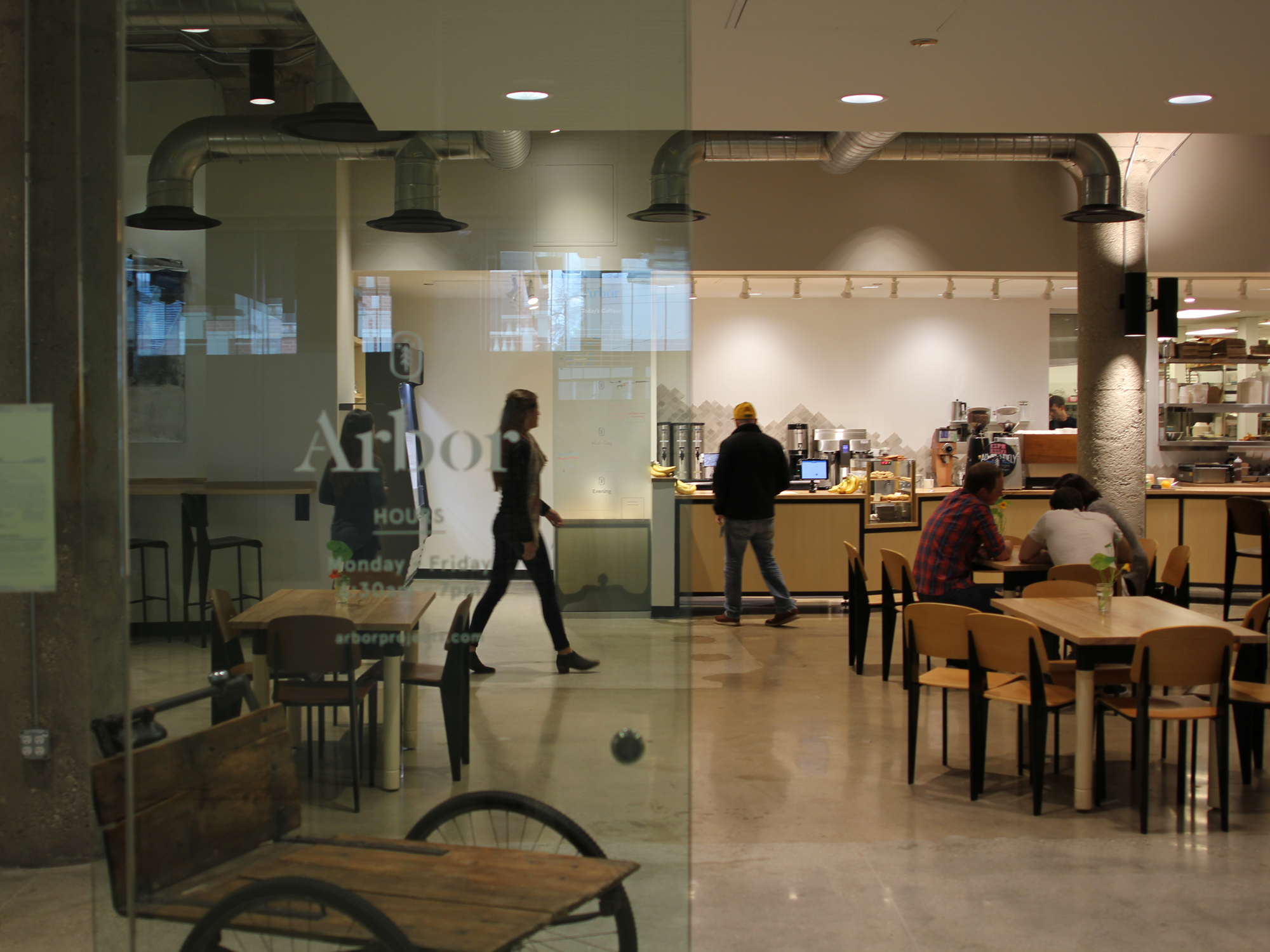PAUL WILLIS OF THORNTON, IOWA, THE FIRST FARMER EVER to sign up with Niman Ranch as a producer, is at Arbor in Chicago, explaining to me and to Arbor chef Leonard Hollander how he wound up selling the prosciutto we’re tasting. How we all ended up at the point we’re at—which is with a highly industrialized and, to his mind, unnatural food system, and how we also have a few rays of natural hope in the picture. (Like the prosciutto we’re tasting.)
“In the 70s I returned to the family farm after I had done some other things,” Willis, fit and soft-spoken as the model of an older farmer, explains. “A neighbor called me up and said, I have a sow and five pigs, if you buy this sow I’ll give you the pigs. I borrowed a boar from the neighbor and started breeding stock. At the time you could pick up used equipment, kind of get in business without a lot of capital outlay. I continued to build this up until I was raising 3000 head a year, I had about 200 sows. Things were going along, I was making some money, getting ahead.”

Paul Willis
You can almost hear the big machines rolling in as he recounts the next turn in the story. “In about the late 80s, early 90s, we started seeing factory farms moving in on us. There were meetings of the co-op, people telling us there we had to get bigger or get out. We should take $100,000, we should put up a confinement building. You can raise more pigs, you can’t exist unless you have 600 sows—and it was all bullshit, really.”
Or, in this case, pig shit. Because CAFOs—confined animal feeding operations, with pigs basically prisoners inside long, low buildings—are most famous for producing massive toxic lakes of hog waste. Willis explains, “I went in one of those buildings and between the odor, and the noise, and the crowded conditions, I just thought, I’m never going to raise pigs like this. If this is the only option, I’m out.”
He stayed in, raising pigs his way—but then he learned something else about a highly commodified meat industry, where every cog in the machine needs to be the same. “With the ‘other white meat’ campaign, they wanted lean pork. I started getting docked—” meaning, his animals, with their meat wrapped in the luxurious layers of fat that a naturally raised pig develops, would earn less money because they didn’t meet the fat-to-meat ratio the market expected. In a commodity system, a better product is no better than a worse product—neither one fits the system.
“They didn’t yield as well because their body cavities—their heart, lungs, everything—were larger,” he says. (Allowing pigs to walk around will do that.) “They had all kinds of reasons for docking you. It annoyed me,” he says, kind of the way Gary Cooper might have said it, as he was contemplating where to aim and how many shots it would take to get the job done.
It was then that Willis discovered, more or less accidentally, that there might still be a market for pork that was raised “wrong”—that somebody might still want better, more natural pork. He was visiting his sister in Santa Rosa, California, and he saw a new concept in local markets—”free range chicken.” If you could get a better price for chickens that get to walk around, he thought, why not for pigs?
But as he says, “It was hard to get people to understand that I was raising whole pigs, not just pork chops.” Selling naturally-raised pigs wasn’t like finding one market so much as it was like creating half a dozen markets at once, for different kinds of meat. One of the things he had done before returning to the family farm was the Peace Corps, and at a reunion, he ran into another rancher he knew. She suggested he talk to a guy named Bill Niman, who was looking to hack the commodity meat business by creating an overarching brand for small family farmers who met certain shared standards of quality.
I went in one of those buildings and between the odor, and the noise, and the crowded conditions, I just thought, I’m never going to raise pigs like this. If this is the only option, I’m out.
“The next day we had lunch at some burger joint in San Francisco, where I had the best burger I ever had in my life, I think,” Willis recalls. He went home and sent some pork straight from his freezer to Niman, who passed it along to a couple of restaurants—including Chez Panisse, Zuni Cafe, and others. “The first time I ever had one of my pork chops that was cooked by a chef was at Zuni—I told my wife it was so good, you’d dream about it. I knew the product was good, but honestly I didn’t know how dramatically different it was. There was a bit of luck involved, because I had the right genetics and I hadn’t gone for the so-called other white meat.”
Then the problem was figuring out how to get pigs from Iowa, where his farm was, to San Francisco. “There’s a system in place, you just have to figure out how it works for you. I took in thirty hogs, in February of ’95, and I started shipping every two weeks. And then they wanted 34 head, and 40 head. And then there came a point where I had to start looking for other farmers.” At that point he earned the designation that Paul Kahan used reflexively when he mentioned Willis to me—”Niman Farmer Number 1.”
Willis would go on to grow much of the pork supply chain for Niman Ranch—both the farmers and the outlets. “Whole Foods was a big loin customer, so that meant we had a lot of end meat with no place to go,” he explains. “If you didn’t have a market for the shoulders and so on, it went to the commodity markets,” which meant that you ended taking a lower price for everything else to create those loins for home cooks shopping at Whole Foods. But then they found a nascent chain called Chipotle, which was looking for high quality pork shoulders for carnitas. Chipotle “took up a lot of that slack,” he says.
He also worked with the Animal Welfare Institute, writing the animal husbandry standards for his kind of naturally raised pork. “I wanted to separate myself from commodity production in every way, shape and form. And of course, animal welfare was a critical part of that. The pork standards were first—now there are turkey standards and chicken standards and everything,” he says. “Those standards led to the Global Animal Partnership—and that led to this,” he says, pointing to a little “bug” on the prosciutto’s packaging that says “Certified Humane.”
If you can’t beat them, join them, and Niman Ranch has long been adept at finding ways to market as smartly to consumers as the big boys in the meat business. Willis no longer raises pigs himself—he’s the head of Niman’s pork business now, managing the supply chain of 600 pork farmers. But he created the humane pork business, he created the standards for the humane pork business—and now he’s selling prosciutto marked with the consumer-level certification that shows that it meets the standards he himself set.

Cured pork products from Niman Ranch (they have to be labeled “uncured” because they don’t contain nitrites, and are cured only with salt)
WILLIS HAS EXPERIENCE WITH HIS OWN ANIMALS becoming prosciutto—he sold hams to Iowa-based La Quercia for many years when he had his farm, and in fact Paul Kahan told me that Willis was the one who first introduced him to Herb Eckhouse of La Quercia at a farmers market in Des Moines. (Willis shrugs and says he has no memory of doing that, but okay.) But creating a market for all the hams produced by Niman Ranch pork producers meant searching the country for a producer who would make prosciutto in the right way.
They found it in Daniele Foods in Pascoag, Rhode Island, a family-owned business making charcuterie by traditional Italian methods. I express surprise that they’re just now getting around to curing hams into a high-value product, but Willis says “It took a while to find somebody to do it. We had some other customers who used product, like Paul Bertolli with Fra’ Mani, but he didn’t have room. It’s a big commitment to stick 10,000 legs in a cooler for a year, and how are they gonna turn out? You can’t make a sample.”
Besides supermarket-ready portions of prosciutto, they’re making salume, and packaging them with other items like olives in what Hollander and I both immediately exclaim to be “Lunchables!” Resemblance to a mass market product, though, isn’t a bad thing—given Arbor’s place in an office building, Hollander is immediately taken with the possibility of having a high-quality, organic snack product to sell to people looking for something to nosh on after lunch.
As we sample, Willis asks Hollander what he thinks of the prosciutto. “It’s amazing. The texture is really nice very silky. Salt seems just right.”

Prosciutto
“It’s very clean,” Willis says. “That seems to be the word that comes to mind. Conventional pork has higher pH, because it’s prone to stress which releases a lot of lactic acid. You get a lot of drip loss, because the moisture is going out of the muscle structure. This muscle structure holds the moisture in.” In fact, that proved to take some adjustment for Daniele—typically prosciutto takes about nine months to fully cure, but this meat, apparently because of its density, takes a year.
Having tasted the pork, I just sit back and let Willis and Hollander trade pork lore. Hollander talks about a little known cut he buys from Beeler’s in Iowa, popular in Spain, called pork secreto—a bit of meat from the flank which Hollander says, “has the flavor of the belly, the richness of the belly in some ways, but it’s way leaner.”
From there they get to all the other cuts Niman is trying to find homes for. “Cheeks, heads, tails,” Willis says. “We sell tails. Not very many people have tails, but having tails on pigs is part of our protocol.”
“Do they normally get docked?” I ask Willis, noting to myself that the same word is used for cutting off part of an animal, and cutting a farmer’s paycheck for that animal.
“All confinement animals are docked,” Willis explains. “Because they have tail-biting, because of the confinement conditions.” He shakes his head. “So you cut it off. Takes care of the problem,” he says sardonically.
THEY’RE JUST NOW INTRODUCING THE PROSCIUTTO—hence this tour meeting chefs, media and buyers for store chains—and right now it’s only in Plum Market in Chicago, but they hope to have it more widely available soon.
Niman’s model is interesting in that it aims for a level of consistency that compares to commodity farming, without strictly dictating to farmers. In some ways it copies the commodity market—Willis talks about the farmers getting docked by Niman if their meat falls outside “the grid,” the grading system, same as the conventional meat system would; the difference is just that theirs is a grid designed to fit these farmers, not the commodity ones.
“You’re not going to tell a farmer who’s been raising hogs for 40 years what he should be raising,” Willis says. “We make recommendations on breeding stock, and mostly [as a farmer] you’re going to know what you need. To increase your litter size a little bit, you’re going to go wth a Chester White boar offspring, that’ll give you another extra pig or two per litter. And then you go back to the Duroc, which is a faster growing pig, and then the Berkshire, which is a darker meat. This combination—the offspring are all better than any of the parents.”
Nina tries to find that balance between industrial uniformity and small farmer individuality, because part of the point is maintaining the future of family farming in America, freed from the slow starvation of down-to-the-last-penny commodity pricing. Niman isn’t the only one looking for an answer to that problem, but it’s had notable success in making a model for the future—Willis talks about Niman farmers as young as 12 and 15, and notes that the average age of a Niman Ranch farmer, at 47, is 11 years younger than the average age of farmers nationally, at 58.
“I hear it from the farmers, that without Niman, they wouldn’t still be farming,” Willis says. “All of these farmers, they wouldn’t be in business without Niman Ranch, because that’s what gives them access to market. In the main commodity world, they’d just be subject to the whims of the market. I feel good about that.”
Michael Gebert is Fooditor editor Number 1.
Latest
Join the Discussion
After you comment, click Post. If you're not already logged in you will be asked to log in or register with Disqus.







